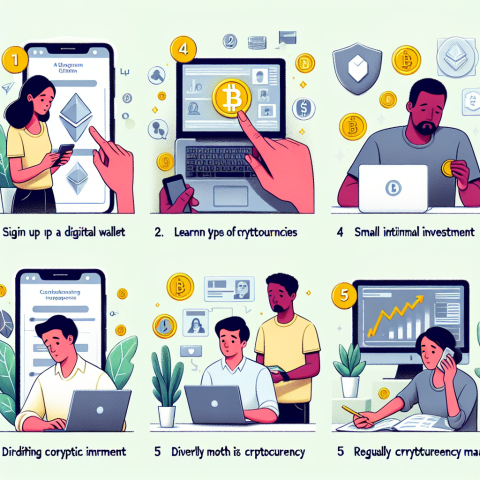Cryptocurrency. The word itself might make you think of confusing jargon, volatile market swings, and tech geeks talking in code. Trust me, I was right there with you. I mean, when I first heard about Bitcoin, I honestly thought it was some kind of internet monopoly money. But the more I dug into it, the more I realized that cryptocurrency isn’t going anywhere. So, if you’re thinking about dipping your toes into the crypto world—whether it’s just to understand it better or to actually start investing—I’ve got you covered. Here are five tips I wish I had when I first started learning about cryptocurrency.

Understanding Cryptocurrency: 5 Tips for Beginners
1. Start With the Basics—Don’t Skip the Research
I’ll be real with you: when I first got into crypto, I rushed into buying Bitcoin because, well, everyone else was talking about it. It seemed like the thing to do. But here’s the thing—I didn’t know what I was actually buying. I didn’t understand blockchain, wallets, or how transactions work. I just assumed it was “digital money.” That was a mistake.
If you’re a beginner, take the time to learn about the fundamentals. Cryptocurrency is built on blockchain technology, which is essentially a decentralized, distributed ledger. Think of it as a public record of transactions that’s updated in real-time. This ensures transparency and security. Understanding this concept is crucial because every single crypto token or coin operates on some form of blockchain.
Start by reading beginner-friendly articles, watching videos, or even using apps like Coinbase that offer educational resources. I didn’t take this step at first, and boy, did I regret it when things got confusing. Trust me, understanding the basics before jumping in will make everything else a whole lot easier.
2. Understand the Risks—It’s Not All Rainbows and Lambos
Let me just say this right now: cryptocurrency can be an emotional rollercoaster. One minute, you’re checking your portfolio, and everything is up 10%. The next minute, the market takes a dive, and you’re holding your breath, wondering if your investments are going to plummet.
When I first started buying crypto, I only looked at the potential for huge gains—like the stories I kept hearing about people who made a fortune by getting in early. But what I didn’t consider was the volatility. Prices can swing wildly in a short amount of time. For example, Bitcoin dropped from $60,000 to under $30,000 in just a few months back in 2022. That kind of fluctuation can be a bit of a shock, especially if you’re not prepared for it.
Before you dive in, make sure you’re mentally prepared for ups and downs. Never invest more than you can afford to lose, and avoid getting caught up in FOMO (fear of missing out). A little tip: If you feel the urge to buy in because the price is going up, take a step back and ask yourself if it’s a good long-term investment. It’s tempting to chase quick gains, but that can lead to some serious stress. I’ve learned to take the longer view, and it’s helped me sleep a lot better at night.
3. Use Secure Platforms and Wallets—Your Coins, Your Responsibility
One of the biggest mistakes I made early on was using a platform with questionable security. Don’t get me wrong, there are some great exchanges out there, but there are also some shady ones. In my case, I chose a smaller exchange that wasn’t well-known. It had low fees, but the security was… well, let’s just say it wasn’t top-notch. I was lucky, but a lot of people aren’t. I’ve heard horror stories of people losing their life savings to hacks.
So, lesson learned: use reputable, secure platforms like Coinbase, Binance, or Kraken. These are well-known, trusted exchanges with solid security protocols. Additionally, make sure to use a hardware wallet (like a Ledger or Trezor) if you’re holding a significant amount of cryptocurrency. These are physical devices that store your coins offline, making it much harder for hackers to access your funds. It’s kind of like having a safe for your crypto.
4. Diversify Your Investments—Don’t Put All Your Eggs in One Basket
I made the rookie mistake of putting all my crypto investments into Bitcoin when I first started. I thought, “It’s the most famous coin, it’s going to be the best one long-term.” Well, guess what? While Bitcoin is still solid, the crypto world has expanded like crazy. There are so many interesting coins and tokens now, each serving different purposes—some of which are actually quite promising.
As I learned more, I realized that diversification was key. I started adding a few altcoins (alternative cryptocurrencies) to my portfolio—Ethereum for its smart contract capabilities, Cardano for its sustainable tech, and Chainlink for its work with decentralized oracles. Now, my portfolio isn’t just dependent on one asset, and I feel much better knowing that I’ve spread my risk across different projects.
When you’re just starting, don’t be afraid to do some research and look at other coins, especially if they solve real-world problems. But again, don’t go too wild—stick with projects that have solid teams and a clear use case. I’ve found that even a small amount of diversification can reduce risk while offering the potential for greater rewards.
5. Stay Informed—The Crypto World Moves Fast
This is a big one, and I learned it the hard way. The crypto market never sleeps. In fact, it moves 24/7, and news can affect prices within minutes. When I first started, I wasn’t following the latest news, and I ended up missing some big developments, like major partnerships or regulatory changes that impacted the market. It was frustrating to see prices go up or down after I’d made a decision.
To stay ahead of the game, make sure to follow reliable sources for crypto news. Websites like CoinDesk, The Block, and even Reddit threads like r/CryptoCurrency are great places to keep up with the latest trends. But don’t just listen to hype—make sure the news comes from a trustworthy source. I’ve seen a lot of misinformation circulate, and it can lead to bad decisions if you’re not careful.
A little advice: Set up Google alerts for specific coins or topics you’re interested in. This way, you won’t miss out on important updates, and you can make informed decisions. Staying informed also helps you to spot potential scams or bad actors in the space, which is crucial in this industry.
To wrap it up, getting into cryptocurrency is exciting, but it’s also a journey that requires patience, research, and a little bit of caution. Don’t rush in just because it sounds cool—take your time, understand the risks, and use secure platforms. Diversify your investments, stay informed, and above all, remember that the crypto world is constantly evolving. If I had done these things when I first started, I would’ve avoided a lot of unnecessary stress. But hey, live and learn! If you take it step by step, you’ll be on the right track in no time.



